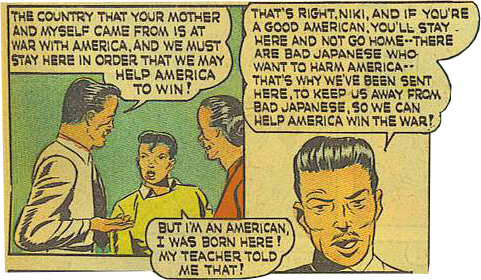In the early 1940s, now-defunct publisher Ace Magazines published Four Favorites, a series of comic books containing tales of four different superheroes. In February of 1943, the series featured a unique story centered around the internment of Japanese-American citizens. While other comics of this time period, such as a Green Hornet story from 1944 , chose to portray internment camps as places of containment for “Jap prisoners of war,” Four Favorites took a much more nuanced view, emphasizing that the interned were full American citizens.

The plot of the story focuses on little Niki Fuji, an American-born nisei boy whose family has been relocated to the Santa Anita racetrack (which aesthetically represents a typical suburb). The old fishing village where they had lived is now the haunt of the faceless Captain Nippo, who has convinced a handful of Japanese followers, including Niki’s uncle, to undermine the United States and fight against the “enemies of the Emperor.” Nippo brags that his terror cell is operating from “under the noses” of “fool Americans”, before Captain Courageous, the superhero of the story, drives him off in a “cloud of American fists.”
Meanwhile, Niki is upset at the loss of his dog, Butch, who had to be left behind, and questions why, as an American, he has to be interned. Niki’s parents attempt to reassure him that part of being “a good American” is staying in the camp so that he can be protected from the “bad Japanese.”

Niki’s parents explain the purpose of internment.
Niki decides to return to the village in search of his dog, only to be kidnapped by his Uncle Saki and Captain Nippo. They take the boy to a hidden submarine which is scheduled to attack an American munitions ship. When Niki threatens to tell the Navy, Captain Nippo (who sees the boy as a “Japanese”) ties him up as a “traitor” and threatens to kill him. Suddenly, Captain Courageous, along with the dog, burst into the submarine, free Niki, and beat up Captain Nippo. Uncle Saki also escapes, but explains that he has to take his punishment for turning against “the country which fed me and sheltered me and gave me my freedom.” He chooses to commit “Hari-kari the American way” by using his own body to block the torpedo tube of Captain Nippo’s sub, which is destroyed in the ensuing explosion. At the end of the story, Captain Courageous congratulates Nikki for his bravery, and reminds readers that “being a real American is a state of mind, not a color of skin.”
This comic is an interesting item for our archive because it’s one of the only known American comic books of the time period to portray Japanese-Americans in a positive light, even if that viewpoint is somewhat complicated by the presence of “bad” Japanese within the same story. As Mine Okubo notes in Citizen 13660, the early 1940s was a period when “the people looked at all of us, both citizens and aliens, with suspicion and mistrust“(12). But, unlike other mass-media publications of the time, Four Favorites doesn’t portray Japanese-Americans as racialized caricatures or sneering villains. In fact, it had the audacity to place a Japanese-American boy on the side of Captain Courageous, the representation of American patriotism — a very unusual act that defied these stereotypes and questioned what it meant to be a true “American.” In many ways, this book was ahead of its time in its more realistic and sensitive portrayals of the trials that Japanese-American citizens faced during wartime.